Antalya City Guide
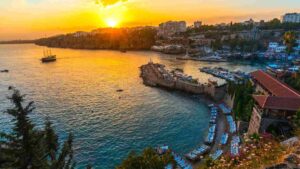
Antalya province is a tourism center in the south of Turkey, located on the Mediterranean coast. The length of the Turkish Riviera Antalya coast extends 630 km. Antalya is the 5th most crowded city and 6th largest city in Turkey. It has a Mediterranean climate, so summers are hot, and winters are cool and rainy.
The cuisine in Antalya is considered quite healthy with meals being cooked with mostly olive oil. Seafood is a big part of the local diet.
Antalya is known for its beautiful natural scenery, beaches, and resorts. It boasts impressive museums and historical landmarks. It is also famous for its large hotels. Nightlife in Antalya is very exciting, and the city hosts various alternatives in terms of nightlife from pubs to nightclubs to Turkish taverns. It’s a great place to visit on your own or with family, and it is also an exciting place to relocate for a longer period of time! We’ve put together this Antalya City guide for expats so that you can find out more about this historic region and all it has to offer.
History of Antalya
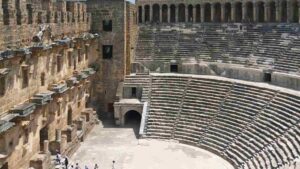
Archaeological excavations show that people have been living in Antalya and its surrounding regions for 40.000 years. Antalya means “Home of Attolos.” Its founder was Attolos II, a king of Pergamum in the 2nd century BC.
After the Pergamum Kingdom’s rule was ended (133 BC), the city stayed independent until 77 BC, when it was annexed as Roman territory by Commander Servilius Isauricus. In 67 BC, Antalya became the base of Pompey’s navy. Hadrian, a former emperor, visited Attaleia in 130 BC. His visit enabled the city to further develop. Antalya was seen as an episcopacy center during Byzantine rule, and after that, the city was conquered by the Turks in 1207 AD under the Turkish Seljuq ruler Kay-Khusraw.
In 1391, it became part of the Ottoman Empire and remained relatively peaceful and stable for the next five centuries. Italy occupied Antalya briefly after World War I. However, in July 1921 Turkish forces drove the Italians out and recaptured the land.
Antalya Museum
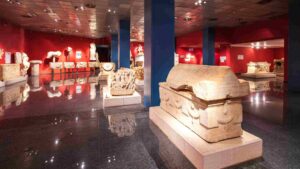
The Antalya Museum was established in 1922 by Süleyman Fikri Ertan. It was established to protect the artifacts recovered from the looting of the occupation forces that came to the region after the First World War. In 1988, the museum was awarded the European Council Private Prize. The museum is composed of 14 showrooms, a child section, and a garden exhibition. Most of the archaeological artifacts in the museum collection were obtained from the periodic excavations carried out by local and foreign scientists in the region, while ethnographic artifacts were collected from the region by museum experts.
The exhibition begins with the finds of Karain Cave, which is of great importance not only for Anatolia but also for the Near Eastern Paleolithic and continues with the finds obtained from the Bademağacı, Karataş Semayük, Bayındır Tumulus, Hacımusalar, Limyra, Patara, Xanthos, Arykanda, St. Nicholas Church, Perge, and Museum rescue excavations. The exhibition was carried out in a chronological order that continues until today.
An important part of Lycia, Pamphylia, and Pisidia, which are the three ancient cultural regions within the borders of the Antalya Region, fall under the responsibility of the Antalya Museum. Among the exhibits are natural history and prehistory collections, statues of gods and emperors, artifacts from burial cults, coins, mosaics and icons.
Pamukkale & Hierapolis
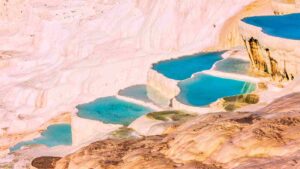
Pamukkale is known for its travertine. Travertine is kind of rock that was formed because of precipitation and various chemical reactions. A wide area was affected by the geoloigacl events that formed Pamukkale thermal springs. This area includes 17 hot water springs which have temperatures between 35- and 100-degrees C. These hot water sources have been in use since ancient times. The hot springs are open to visitors throughout the year, however, the best time to visit is during the summer because it offers the chance to see the travertines much closer.
The history of Pamukkale goes back to the Roman Period and most of the ruins of Hieropolis are from this period. Although the information about the foundation of the city is limited; it is known that it was founded at the beginning of the year by King of Pergamum Eumenes II. in the 2nd century BC. It took the name Hierapolis because of Hiera, the queen of the Amazons, the wife of Telephos, the legendary founder of Pergamum. Hierapolis is on the UNESCO World Cultural and Natural Heritage List.
Two thousand years ago, the waters of Hierapolis were believed to have healing properties and it became a health center. The city has been visited by people from various parts of Anatolia seeking health and beauty for thousands of years.
The ruins include a Roman bath, statues, an ancient theatre, temples, monumental foundations, tombs, an agora, and a gymnasium.
Hierapolis is also a holy settlement for Christianity. The most important reason for this sanctity is that Philip, one of the 12 apostles of Jesus, was killed here and his grave is here. The Martyrium, which is another sacred structure in Christianity, was built by palace architects in the 5th century and is where the saint’s tomb is located.
Other important Christian structures are the 6th-century cathedral, which includes the baptismal vessel and bishop’s liturgy, and the Direkli Church, which dates back to the 7th century. There are also many smaller churches throughout the city. Because of these structures, it can be said that Hierapolis was a religious center during the Byzantine Period.
The Parks of Antalya
Köprülü Canyon National Park
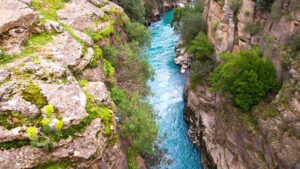
The value of the national park comes from the 14 km long split valley formed by the Köprüçay River. Cliff heights exceed 100 m in places. The park is spread over an area of 35,719 hectares in Antalya. The Köprüçayı River is also a popular rafting area. Köprülü Canyon National Park also hosts the ruins of Selge Ancient City. There are also stone terraces, bridges and roads belonging to various historical periods in the national park area.
Kurşunlu Waterfall Nature Park
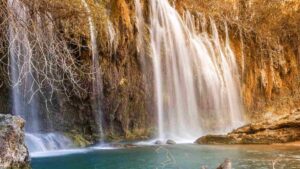
Kurşunlu Waterfall National Park has an area of 33 hectares and the waterfall spills from a height of 18 meters. The park has seven ponds with waterfalls between them. Observation terraces, playgrounds, car parks, and other facilities are also available for visitors.
Beydağları Coastal National Park
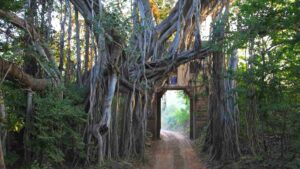
Beydaglari Coastal National Park was declared a national park in 1972. Its area is 31,165,88 hectares.
The national park is located in the ancient Lycia region. It hosts the ancient cities of Idyros, Olympos and Phaselis, as well as Mount Chimera. The famous flame on Mount Chimera has been burning for thousands of years and is the subject of chimera and bellerophone legends in the famous poet Homer’s Iliad epic.
In addition to land mammals such as bears, wolves, foxes, wild goats, lynx, squirrels and porcupines, Mediterranean monk seals are also occasionally encountered on the coasts. Tekirova and Çıralı Beaches, where sea turtles lay eggs, are under special protection.
Domestic and foreign tourists coming to visit the region can benefit from the tourist facilities, daily areas for tourists to hang out, break points for hikers, tour routes, and the cable car line installed on Tahtalı Mountain.
Saklikent National Park
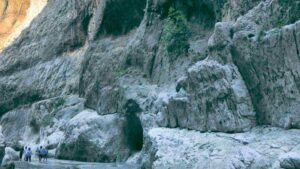
Saklikent is a famous, beautiful canyon that has very steep valley slopes at an altitude of 1000-1100 meters. It can be entered by a 200-meter suspension bridge. There is snow in the mountains during the winter, so it’s recommended to visit this canyon after April. A stroll through the canyon takes the visitors’ breath away with the views of one of the deepest valleys in the world. It is known as “Hidden Valley” or “The Lost City.” There is very cold water flowing through the valley which visitors can wade through, making this a great way to cool off during the summer months! The park also boasts a waterfall.
Güllük Mountain – Termessos National Park
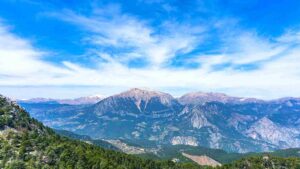
It was declared a national park in 1970 and its area is 67,020 hectares. On Güllük Mountain, rising from the travertine plains of Antalya, are the ruins of the city of Termesos, founded by the Solims, one of the Indigenous peoples of Anatolia. The endangered fallow deer lives in the national park. In addition to mammal species such as wild goat, caracal, and marten, rare predators such the imperial eagle are also seen.
Altınbeşik Cave National Park
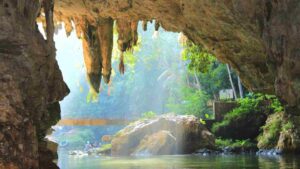
Altınbeşik Cave bears the traces of millions of years of geological processes. Altınbeşik Cave, which is 2,500 meters long, is a natural wonder worth seeing with its stalactites and stalagmites. This cave contains the largest underground lake in Turkey and the third largest in the world. You can explore the cave with excursion boats.
Best Spots Around Antalya
Perge
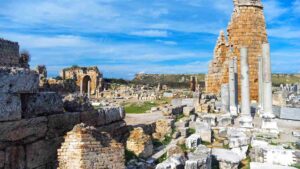
The ancient city of Perge used to be known as “Parha” and is believed to have survived since the Hittite period. It was one of the most organized cities of Anatolia during the Roman period. The ancient city is famous for its architecture and marble sculpture. The sculptures found in the excavations in the ancient city have made the Antalya Museum a nationally recognized attraction.
Belek
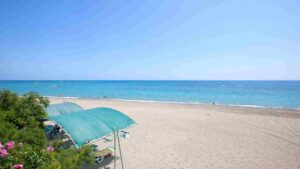
Belek is in the middle of a rich water basin known as Pamphylia in ancient times. Research conducted in Pamphylia show that civilization in these lands dates back to the Paleolithic age. You can come across mysterious traces of history in Belek. Today, Belek contains one of the largest hotels in Turkey, it is also famous for its golf courses. Aspendos Ancient City, Sillyon Ancient City, Selge Ancient City Amphitheater, and the Apollon Temple are all located in Belek.
Side
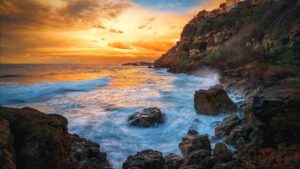
Side has a cultural heritage worth seeing with its temples from the Byzantine Period and its history dating back to the Hittites. The foundation of Side Antique City dates to 7 BC. Side’s tourism region will enrich your holiday thanks to its historical treasures as well as beauties such as its theatre, waterfall, and national park. Visitors can enjoy the natural scenery and the port city’s history by signing up for a yacht or Jeep safari tour!
Manavgat
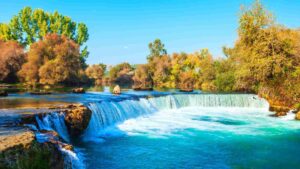
Manavgat is one of the biggest districts of Antalya. The history of Manavgat dates to the Hitite period and there are artifacts from the Hellenistic, Byzantine, and Roman periods. It is known that it was among the most famous ports of the region during this time. Manavgat tourism activities include canyon boat tours, Jeep safari adventures and water sports activities.
Beşkonak
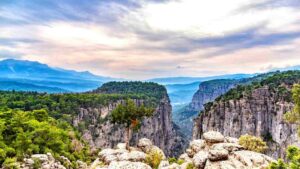
Beşkonak is famous for rafting. Like the İkiz plateau, it has magnificent plateaus on the foothills of the Taurus Mountains. Beşkonak has come a long way in the field of rafting in Turkey and hosts thousands of adrenaline lovers in the summer season.
Alanya
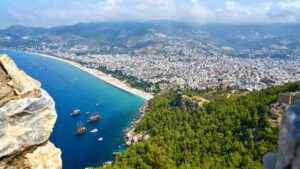
Alanya is known for being one of Turkey’s leading summer holiday destinations that boasts various beaches and many cultural and entertainment activities. Alanya is a small district; however, it is known for being the most densely populated district of Antalya. Alanya was valued by many different civilizations such as Byzantine, Persian, Mamluk, Roman, Ottoman, and Seljuk. Its name comes from the Seljuk period.
Frequently Asked Questions (FAQ)
What is the best time to visit Antalya?
The best time to visit Antalya is from May to September. However, one should be careful because during summer the temperature gets quite high. Nonetheless, summertime is definitely the part of the year when the city is most alive, and you will be able to take full advantage of the beaches.
How do I travel to Antalya?
Since Antalya is a major tourist destination, you can reach Antalya with flights from various locations around the world. You can also fly to Istanbul and take a bus from there.
How will I get around?
If you’ll be a long-term expat, you may want to invest in a car. If you’re visiting fort a shorter time, Antalya also has busses available, especially closer to the city center, and there are plentiful taxis as well.
Guide for Istanbul ?
Do you need a guide for Istanbul. Here you can read our Istanbul City Guide for Expats.
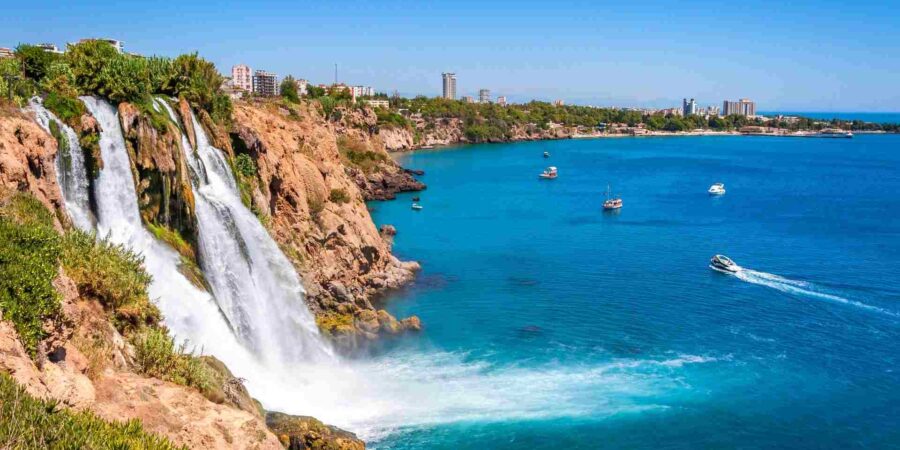

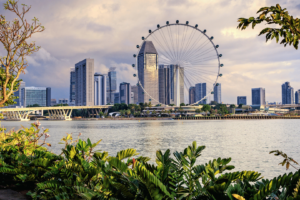
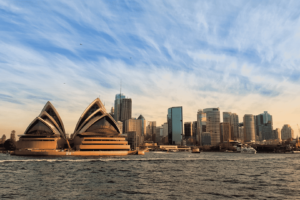
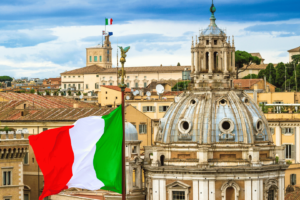
One comment
Great blog here! Also your site loads up very fast! What web host are you using? Can I get your affiliate link to your host? I wish my website loaded up as fast as yours lol